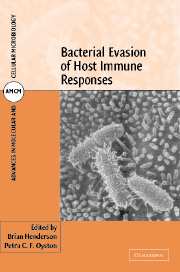Book contents
- Frontmatter
- Contents
- Contributors
- Preface
- Part I Recognition of bacteria
- Part II Evasion of humoral immunity
- Part III Evasion of cellular immunity
- 7 Type III secretion and resistance to phagocytosis
- 8 Bacterial superantigens and immune evasion
- 9 Bacterial quorum sensing signalling molecules as immune modulators
- 10 Microbial modulation of cytokine networks
- 11 Enterotoxins: Adjuvants and immune inhibitors
- 12 Type III protein secretion and inhibition of NF-κB
- Index
- Plate section
- References
12 - Type III protein secretion and inhibition of NF-κB
from Part III - Evasion of cellular immunity
Published online by Cambridge University Press: 13 August 2009
- Frontmatter
- Contents
- Contributors
- Preface
- Part I Recognition of bacteria
- Part II Evasion of humoral immunity
- Part III Evasion of cellular immunity
- 7 Type III secretion and resistance to phagocytosis
- 8 Bacterial superantigens and immune evasion
- 9 Bacterial quorum sensing signalling molecules as immune modulators
- 10 Microbial modulation of cytokine networks
- 11 Enterotoxins: Adjuvants and immune inhibitors
- 12 Type III protein secretion and inhibition of NF-κB
- Index
- Plate section
- References
Summary
INTRODUCTION
When faced with a bacterial pathogen, the multicellular organism raises a series of defense responses involving both the innate and adaptive immune systems. The innate immune system refers to the first-line host defense, which confers immediate antimicrobial activities. Professional phagocytes, such as neutrophils and resident macrophages, largely constitute the cellular components of innate immunity. These cells directly attack the invading pathogen, mediate secretion of proinflammatory cytokines (see Chapter 10), and mount a protective inflammatory response. In addition to these early defense responses, the innate immune system facilitates the maturation of subsequent adaptive immunity. Both the innate and adaptive immune responses serve to eliminate the infectious challenge. However, to prevail within the host, pathogenic bacteria have evolved sophisticated strategies for evasion or neutralization of host defense mechanisms. A broad range of pathogenic Gram-negative bacteria, including phytopathogens, utilize the type III protein secretion system as a powerful tool to modulate immune responses of the host, which first enables disease.
The type III protein secretion systems are complex weapons that specifically mediate polarized delivery of bacterial virulence proteins directly inside eukaryotic cells (Galan and Collmer, 1999; Donnenberg, 2000). These secretion machineries are composed of approximately twenty proteins, which form a needle complex that protrudes from the inner bacterial membrane to the attached eukaryotic cell. The type III protein secretion systems are first activated when the bacteria come into contact with the host cell.
- Type
- Chapter
- Information
- Bacterial Evasion of Host Immune Responses , pp. 279 - 294Publisher: Cambridge University PressPrint publication year: 2003

